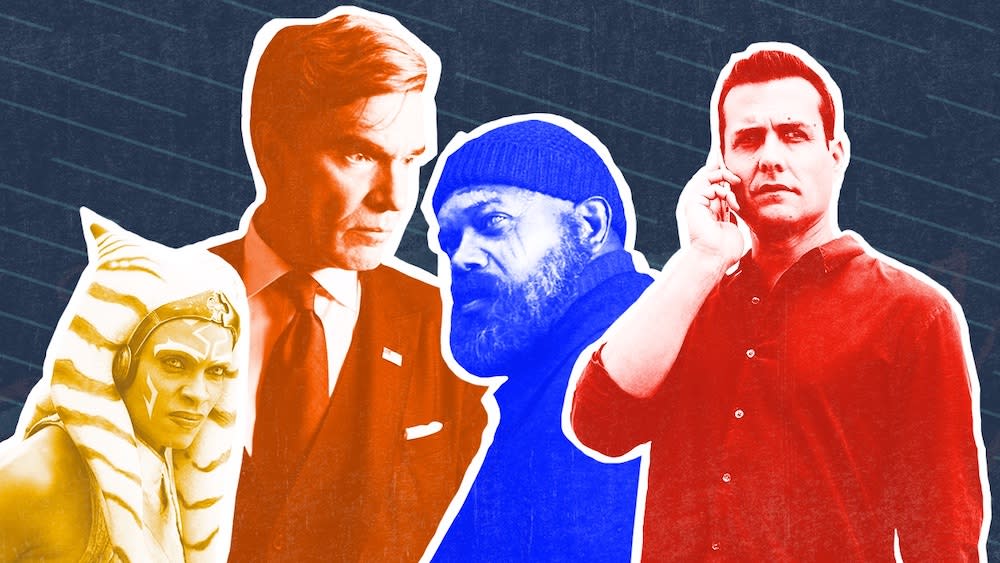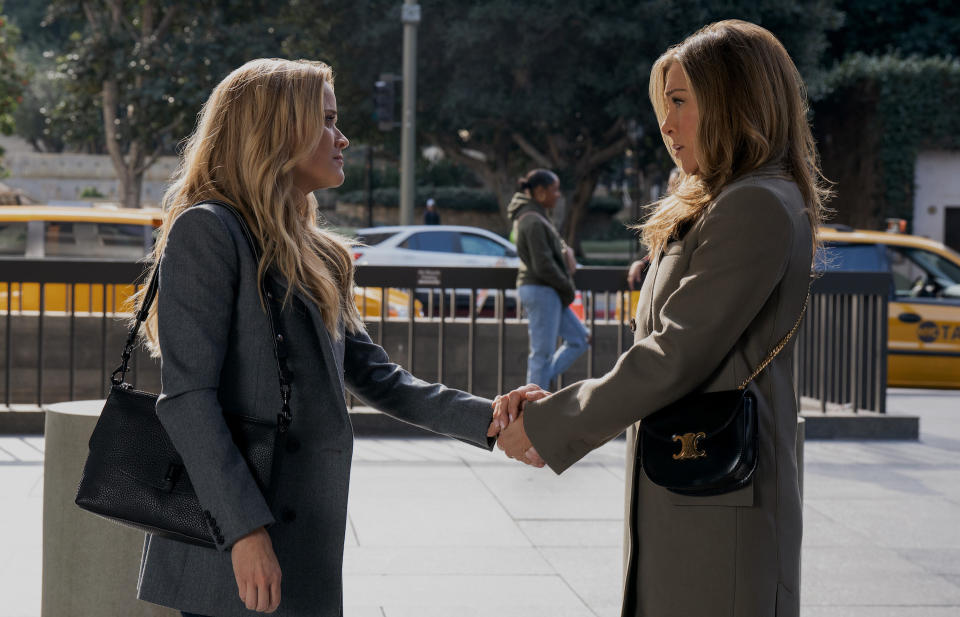This Was the Year That TV Regressed

- Oops!Something went wrong.Please try again later.

As we wrap up our year-end coverage, IndieWire looks back at the people, projects, and ideas that defined 2023 — and what’s coming next.
I miss the days when Hollywood believed a great TV show could sustain an entire network. You know, back when television was still growing, and rising brands were built around groundbreaking, widely respected original programs. HBO was where you watched “The Sopranos,” AMC had “Mad Men,” and Netflix streamed “Orange Is the New Black.” Premium cable expanded to basic cable, which expanded to streaming, which expanded and expanded and expanded — almost always by touting the next great series as the best reason to tune in, sign up, or seek out a previously undiscovered channel in your satellite guide.
More from IndieWire
Glen Powell Says He's Reuniting with Ryan Murphy for a Broadway Musical
Julianne Nicholson Is '100%' Down for More 'Mare of Easttown' but Is 'Not Losing Sleep Over It'
Those days have been over for some time now, but as the sun set on TV’s modern golden age and the vast universe of Peak TV dawned before us, there were still stars sparkling in the sky. Exciting new series held their place in a network or service’s plan for continued growth. “Ted Lasso” helped put Apple TV+ on the map. “Yellowstone” is the red-hot magma nursing Paramount mountain. “Andor” may be the only outstanding original Disney+ will ever make. But these shows are not those shows. They’re shorter (“Andor” will only run two seasons), they’re more familiar (“Ted Lasso” remains indebted to “Major League”), and they’re, by and large, less ambitious. (Even Kevin Costner knows “Yellowstone” isn’t that good.)
So how did we get here? What happened in between to rein in television’s enterprising spirit? Short answer: Peak TV. Longer answer: The Peak TV era — when every streamer thought an abundance of original programming was key to winning the streaming wars — was built from companies investing billions upon billions to attract subscribers, only to then witness market forces shift toward a radical new metric for healthy businesses: profitability. And when you’re judged by what makes money, you’re going to play things pretty safe. In the past year, Peak TV’s obituary has been written many times, as Hollywood pivots from “too much TV” toward reasonable spending and risk-averse programming. Now, we’re living through Trough TV, Algorithmic TV, or Post-TV — monikers that don’t exactly inspire hope for the present state of television. But each epitaph isn’t just about what’s happening now, it’s also asking “What’s next?” And each underlying answer carries the familiar thrum of fear.
This year is pivotal. Between the WGA and SAG strikes setting new terms, the great streaming correction shifting programming priorities, and multiple landmark series coming to a close, a turning point is here, whether we’re ready or not. TV is changing yet again. It will evolve, stagnate, or regress. And in 2023, there were far too many signs of regression.
Too Much TV? More Like Too Much Bad TV
Some signals are almost too obvious — aka “all the bad TV shows.” While these can nearly be written off as the subjective complaining of a snobby critic (hello, it’s me), the issue in 2023 wasn’t just how many inept series there were, it’s that they seemed to be popping up from every direction. There were your awful attempts at extending IP (Peacock’s “The Continental,” Max’s “Velma”) and your soulless revivals (Paramount+ with “Frasier,” Netflix’s “That ’90s Show”). Franchises new (Prime Video’s “Citadel”) and old (“Ahsoka” was a disappointment, “Secret Invasion” something worse) fell apart. Even HBO — still widely considered the pinnacle of original programming — dropped an objective dud in “The Idol.”
A spike in substandard TV is hardly a crisis, and there are still plenty of exciting episodic entries out there. But regardless of how much dreck is in the cask, only looking at the bottom of the barrel won’t tell the full story. So let’s consider Hollywood’s top content producer, Netflix. “The Crown’s” gradual descent from perennial Emmy winner to tawdry puppet theater may best reflect the streamer’s not-so-original programming of late, but let’s look at the numbers, since we have them. What were the biggest hits for the streamer behind legitimately great 2023 shows like “Never Have I Ever,” “Derry Girls,” and “I Think You Should Leave”? Well, “The Night Agent,” “Ginny & Georgia,” and “FUBAR,” of course!
It’s not that these shows are bad — they are, but let’s set that aside for a second — it’s that Netflix was able to bounce back from the panic-spiral of 2022 and win the streaming wars by serving extra helpings of faux-gourmet cheeseburgers the very next year. (To be fair, “The Night Agent” could pass for a Wendy’s Double Stack, but “G&G” and “FUBAR” are 3 a.m. White Castle orders, at best.) Toss in acquired sensations like “Suits” and parasitic stunts like “Squid Game: The Challenge,” and it’s clear that quality was not king for Netflix this year. To conquer TV, it didn’t need great art, it just needed watchable content.
Faux Prestige Fakes Its Way to the Top
If history is written by the winners, then it’s easy to see how Netflix’s influence has crept across the small screen. Even in the Peak TV era, networks still valued buzzy, brainy originals like “The Americans,” and “Succession.” They weren’t as instrumental to the business as massive money-makers like “Game of Thrones” or “Stranger Things,” but these cultural conversation-starters and awards darlings were still considered key to brand identity, reducing subscriber churn, and attracting top-tier talent.
That philosophy seems to be fading. Algorithmic believers, like Netflix, are happy to rely on formula over imagination. “The Night Agent,” “Ginny & Georgia,” “Outer Banks” — we’ve seen versions of these shows before, which makes them relatively safe bets compared to untested ideas. Ironically enough, the same kind of thinking has driven broadcast television for decades: Don’t step outside the box, just give the people more of what they already have.
Netflix will still make prestige plays, but even those can often feel couched by the defensible lanugae of studio comps. Some are derivative of previously successful series (“The West Wing” x “Homeland” + Keri Russell = “The Diplomat”), others are literal extensions of popular properties (“Queen Charlotte: A Bridgerton Story”), and still more are adaptations of previously successful series (the live-action “One Piece”). The risk is lessened by their similarities to past successes, but actual originality takes a hit, too.
Still, it’s not just Netflix that’s more comfortable with prestige TV imitations. Some of the most buzzed about shows of the year are not driving conversation through insightful, elegant storytelling; they’re doing so by faking insightful, elegant storytelling.

Just look at “The Morning Show,” a series that started off shaky and then drove off a cliff. (If you know, you know.) At best, Apple’s convoluted drama is entertaining camp, and yet the reception for its third season (which remains bad) is like watching the Oscars throw a parade for “The Paperboy.” So much coverage, so many viewers, and now awards… for this? Comparing “The Morning Show” with the likes of “Succession” — as multiple voting bodies have already done — requires a whiplash-inducing level of cognitive dissonance. They both have their place in a proper TV universe, but let’s not pretend each is cut from the same cloth. One is rooted in reality, the other in unreality.
Honestly, I blame “And Just Like That” Season 2 for scrambling our brains (though it could’ve started even earlier this year, when “Ted Lasso” Season 3 completely collapsed): Here is the image of an all-time great series (“Sex and the City”), inexplicably reanimated into nonsensical actions. It’s not only hard to look away — as many discovered during what should’ve been an innocent summer fling — it’s impossible to reconcile how the two shows can coexist. The great and the inane. Perhaps that’s why its successors in the 2023 timeline — “The Morning Show,” “Loki” (with a second season that proved Marvel doesn’t know how to make television), and now “The Gilded Age” (pretty gowns, all the way down) — are being treated like actual royalty.
OK, OK — I realize I’m treading back into whiny critic territory, so let me say that I watched every episode of “The Morning Show” (and “The Gilded Age,” and “And Just Like That”), and I even enjoyed some of them. (My coworkers will likely argue “enjoyed” is a too timid description.) But, to borrow the Netflix jargon once more, confusing gourmet cheeseburgers with prime rib is a recipe for disaster. Our cultural bar for greatness simply can’t be set this low without risking long-term regression. If these shows are treated like the best TV has to offer, what happens to the shows that really challenge us, that are truly bold, that can carry the weight and nuance of life? What are we missing when we give all attention over to beautiful stars, beautiful gowns, and the fleeting beauty of nostalgia? What are we saying we want from television? What are we saying is good enough to be here?
What’s Lost When We Settle for Less
People watched a lot of bad TV in 2023. People watched a lot of bad TV that pretended it was good. But we also lost a lot of truly great TV; shows like “Succession,” “Reservation Dogs,” and “Barry.” Comforting mainstays like “Billions,” and “Archer” came to an end. A number of exciting series were canceled or ended prematurely, like “American Auto,” “1899,” and “The Great,” not to mention those rare birds built from I.P. but with brains of their own, like the dark-and-gritty “Perry Mason” reboot and the TV adaptation of “Blindspotting.” But most troubling among the shows forced off the air were how many featured people of color, women, and LGBTQIA individuals, including “Grand Crew,” “A Black Lady Sketch Show,” “Swagger,” “Kindred,” “South Side,” and “A League of Their Own.”
The Peak TV era had its problems, but space wasn’t one of them. The demand for more shows created opportunities, and ample new talent did more than just fill the void; they made it their own. One has to wonder who will get the chance to tell stories in TV’s next era. With less space, where will those resources go? More franchises? More I.P.? More of the same? Meanwhile, audiences have to contend with rising subscription costs and shows disappearing from libraries. Whenever the next great TV show does come out, how will they find it?
So much is changing. So many decisions have to be made. Just as no one really knows what the next “Game of Thrones” will be, no one really knows what’s next for television. But whether it evolves or regresses is up to us. What we choose to watch still plays a part in what gets made. Do we really want to go back to the days when TV didn’t make room for a wide array of perspectives? Do we really want to go back to when TV was considered a step-down for Hollywood talent? Do we really want to go back?
So choose wisely, dear readers. Peak TV is over, but TV still has plenty of room to grow.
Best of IndieWire
Where to Watch This Week's New Movies, Including 'The Iron Claw' and 'All of Us Strangers'
2023 Movies Shot on Film: From 'Oppenheimer' to 'Killers of the Flower Moon' and 'Maestro'
Quentin Tarantino's Favorite Movies: 59 Films the Director Wants You to See
Sign up for Indiewire's Newsletter. For the latest news, follow us on Facebook, Twitter, and Instagram.

